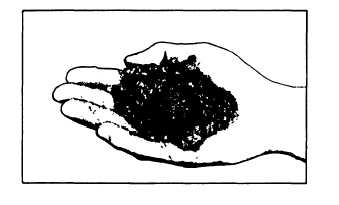8. Determine the quantities for the first trial batch. Let’s assume that the size of our
laboratory trial batch is 1 cubic yard. For a batch of this size, you need the following
quantities
l
l
l
l
l
of the ingredients:
Cement Type IA
= 610 pounds 94 pounds per sack
= 6.49 sacks
Water
= 305 pounds 8.33 pounds per gallon
= 36.6 gallons
Coarse aggregate = 1,735 pounds
Fine aggregate = 1,152 pounds
Air content = 5.0 percent
If needed, more trial batches should be mixed to obtain the desired slump and air content
while you keep the water-cement ratio constant.
Variation in Mixtures
The proportions at which you arrive in determining
mixtures will vary somewhat depending upon which
method you use. The variation is the result of the
empirical nature of the methods and does not necessarily
imply that one method is better than another. You start
each method by assuming certain needs or requirements
and then proceed to determine the other variables. Since
the methods begin differently and use different
procedures, the final proportions vary slightly. This is to
be expected and points out further the necessity of trial
mixtures in determining the final mixture proportions.
Adjustments for Moisture in Aggregates
The initial mix design assumes that the aggregates
are saturated, surface dry (SSD); that is, neither the fine
aggregates nor the coarse aggregates have any free
water on the surface that would be available as mixing
water. This is a laboratory condition and seldom occurs
in the field. The actual amount of water on the sand and
gravel can be determined only from the material at the
mixing site. Furthermore, the moisture content of the
aggregates will change over a short period of time;
therefore, their condition must be monitored and
appropriate adjustments made as required. Coarse
aggregates are free draining and rarely hold more than
2 percent (by weight) of free surface moisture (FSM)
even after heavy rains. A good field test for estimating
the FSM on fine aggregates is the squeeze test described
below.
l The squeeze test.
1. Take samples for the squeeze test from a depth
of 6 to 8 inches below the surface of the piled sand. This
negates the effect of evaporation at the surface of the
pile.
2. Squeeze a sample of the sand in your hand. Then
open your hand and observe the sample. The amount of
FSM can be estimated using the following criteria:
a. Damp sand (0- to 2-percent FSM). The
sample will tend to fall apart (fig. 17-1). The damper the
sand, the more it tends to cling together.
b. Wet sand (2- to 4-percent FSM). The sample
clings together without excess water (fig. 17-2).
c. Very wet sand (5- to 8-percent FSM). The
sand will ball and glisten or sparkle with water (fig.
17-3). The hand will have moisture on it and may even
drip.
Figure 17-1.—Damp sand.
17-8


